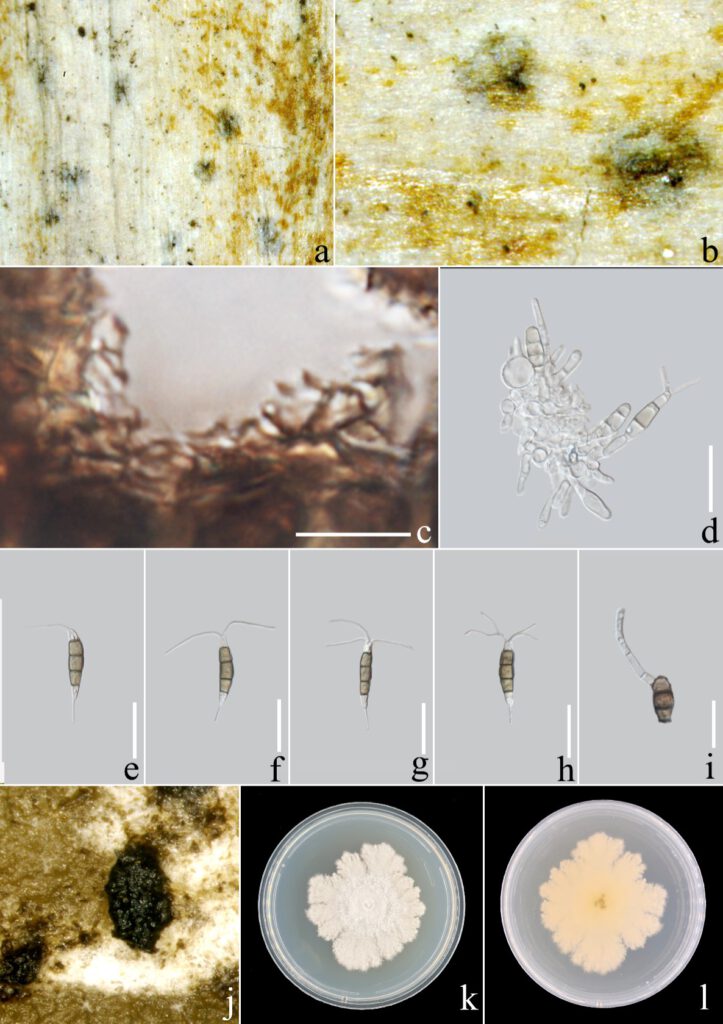Pestalotiopsis guangdongensis Y.R. Xiong, Manawas., & K. D. Hyde, in Xiong, Manawas, Maharachchikumbura, Lu, Dong, Xiang & Xu, Curr. Res. Envir. & App. Myc. 12(1): 308 (2022)
Index Fungorum number: IF 559616; MycoBank number: MB 559616; Facesoffungi number: FoF 10809;
Etymology – Epithet refers to the locale from where the fungus was isolated.
Holotype –ZHKU 22–0011
Saprobic on Arenga pinnata rotting leaf. Sexual morph: not observed. Asexual morph: Conidiomata immersed beneath inconspicuous, intra- or subepidermal, ellipsoidal domes on the host surface, black, coriaceous, scattered. Conidiophores mostly reduced to conidiogenous cells, branched or unbranched, circular, hyaline, smooth-walled, up to 7.5 µm long. Conidiogenous cell 5.5 × 7 µm, discrete, smooth-walled, hyaline, ampulliform or subcylindrical. Conidia 27–39 × 8–11 µm (x̄ ± SD = 33.5 ± 3.6 × 9.6 ± 0.8 µm, n = 40), fusoid, ellipsoid, 4-septate, straight to slightly curved, slightly constricted at septa; basal cell 4–8 µm long, conic with a truncate base, hyaline, verruculose and thin-walled; three median cells 20–26 µm long, x̄ ± SD = 22.5 ± 2 µm, doliiform, verruculose, concolourous, olivaceous, septa darker than the rest of the cell (second cell from the base 6–8 µm; third cell 7–10 µm; fourth cell 7–10 µm); apical cell 4.5–7 µm long, hyaline, verruculose, subcylindrical to conical, smooth-walled; apical appendages 12–43 µm long, x̄ ± SD = 28 ± 7 µm, 1–4 (seldom 4), tubular, arising from the apical crest, unbranched, filiform; basal appendage 2–13 µm long, single, tubular, unbranched, centric,.
Culture characteristics – Colonies on PDA attaining 6 cm diam after 7 d at 25 ℃, irregular, convex in the middle with papillate surface, lobate, rugose, buff, undulate; reverse cream.
Material examined – China, Guangdong Province, Guangzhou City, South China Botanical Garden, rotting leaf of Arenga pinnata, 17 December 2020, Y.R. Xiong, ZHKUCC 22–0016 (ZHKU 22–0011, holotype) – living culture in ZHKUCC; ibidem, 17 December 2020, Y.R. Xiong, ZHKUCC 22–0017 (paratype) – living culture in ZHKUCC; 17 December 2020, Y.R. Xiong, ZHKUCC 22–0018 (paratype) – living culture in ZHKUCC.
Known distribution – widespread in tropical and subtropical regions.
Notes – Three isolates obtained in this study from an independent clade in Pestalotiopsis phylogenetic tree with 53 % ML, 68 % MP bootstrap values and 0.84 BYPP values. Pestalotiopsis guangdongensis was phylogenetically close to P. anacardiacearum, and P. hawaiiensis. Pestalotiopsis guangdongensis have 1–4 apical appendages, and P. anacardiacearum has 2–3. Although the size of the conidia of P. guangdongensis is similar to that of P. anacardiacearum, the sizes of basal cells, median cells and apical cells are different (Table 3). In addition, there is no evidence of significant genetic recombination (Fw = 1.0) in the PHI analysis. Based on polyphasic approaches, the isolates obtained in this study was identified as P. guangdongensis, a new Pestalotiopsis species.

Figure. Pestalotiopsis guangdongensis (ZHKU 22–0011). (a, b) Conidiomata on the rotting axis of Arenga pinnata; (c) Peridium; (d) Conidiogenous cells giving rise to conidia; (e–i) Conidia; (j) Pycnidium; (k) The front view of a two-week-old colony on PDA; (l) The reverse view of a two-week-old colony on PDA. Scale bars: c = 20 µm; d–h = 30 µm; i = 15 µm.
